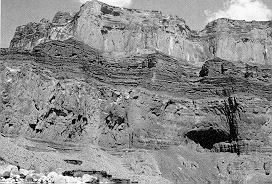Lime Mud Deposits?
Shallow-water lime muds in today's tropical oceans accumulate at a rate of one foot thickness per one thousand years. These muds are formed by mechanical breakdown of carbonate containing sea creatures. Modern muds are believed by evolutionists to provide an excellent example of how ancient lime mudstones ("micritic limestones") were accumulated in Grand Canyon. Even some creationists believe that the evidence from lime muds is so convincing that one must certainly believe in long ages of slow deposition for Grand Canyon limestones. Dan Wonderly, for example, insists that all one has to do is compare the modern lime muds with the texture of the Redwall Limestone of Grand Canyon to be convinced that the Canyon strata required millions of years to be deposited.1 Wonderly claims that young-earth creationists, in a very deliberate way, ignore or neglect these data, which prove slow deposition.
There are strong dissimilarities, however. Modern "shallow water" lime muds are dominated by "silt sized" crystals (approximately 20 microns in diameter) of the mineral aragonite (most contain 60 to 95% aragonite, and O to 10% calcite) derived from disaggregation or abrasion of skeletons of marine organisms. 2 Ancient lime mudstones ("micritic limestones") are abundant in Grand Canyon, and are dominated by "clay sized" crystals (less than 4 microns in diameter) of the mineral calcite (nearly 100% calcite and/or dolomite) with "sand sized" and larger skeletal (shell) fragments floating in the fine crystal matrix. 3
Geologists emphasize the textural, mineralogical, and chemical differences between modern lime muds and many ancient limestones:
Micritic limestones, composed essentially of calcite, have textures quite different from those of the aragonite dominated modern lime muds that long have been regarded as their precursors. 4
and again:
Modern carbonate sediments contrast sharply in their chemistry and mineralogy with ancient carbonate rocks. 5
Even the shapes of the grains are strongly discordant between the modern and ancient lime muds:
Furthermore, the grain (crystal) size distribution and grain (crystal) shape characteristics of modern lime mud sediment are very different from their lithified counterparts. 6
Could some process of recrystallization have been responsible for transforming these modern coarser textured aragonite muds into the finer textured calcite muds which compose limestones? This is a much disputed question. The process of recrystallization, it has been recognized, makes larger crystals from small crystals, not smaller crystals from larger ones. How could such a process form the dominantly fine-grained muds which now compose limestones? Early workers on the microcrystalline calcite ("micrite") ooze of ancient limestone argued that it formed by direct precipitation from sea water, 7 not from recrystallization or even extensive abrasion of skeletons of marine organisms. This process, believed to form ancient lime muds, is much different from slow processes in modern oceans. The "lime mud problem" has become more apparent in recent years, as the compositions and textures of modern lime muds and fine-grained limestones have been more thoroughly investigated.
At the present time, it would be inappropriate to suppose that the scientific evidence requires that ancient fine-grained limestones were derived from lime muds resembling the muds being deposited slowly in modern tropical seas. Evolutionists may make the assumption, but the facts do not justify it. In the words of F.J. Pettijohn, "The origin of micrite is far from clear." 8
Fossil Reefs?
An important problem to be faced by the Bible believing geologists is the existence of alleged limestone "reefs." 9 Critics of the Flood theory say that many abundantly fossiliferous limestones are organically constructed "reefs," which were accumulated slowly along the edge of an ancient sea. The Flood, some critics say, could not have deposited such structures, because it took thousands of years to construct a huge wave resistant framework, as innumerable generations of organisms chemically cemented themselves, one on top of the other. If Grand Canyon limestones were accumulated slowly in tranquil seas, we might expect to have large, organically bound structures ("reefs") buried with the lime mud. Do large, organically bound structures occur within Grand Canyon limestones? Can these be proven to represent in situ, slowly accumulated sea floor?
The most extensive study of Grand Canyon limestone was by McKee and Gutschick. They admit, "Coral reefs are not known from the Redwall Limestone." 10 Concerning laminated algal structures (stromatolites) which might form slowly in tidal flat environments, they say, "the general scarcity or near absence of bottom building stromatolites suggests that places generally above low tide are not well represented." 11 The cautious statements concerning algal structures in Redwall Limestone were used by Dan Wonderly to argue against the Flood. He uses these statements to imply that some of the algal structures indeed represent in situ ocean floor. 12 A careful study of McKee and Gutschick's work shows that the laminated algal structures typically show concentric structure (oncolites), and are best interpreted as algal masses which have been transported by rolling. These authors believe that the Redwall Limestone represents in situ ocean floor deposits, but they have not proven their case with empirical evidence.

Rapid Deposition
Evidence of rapid deposition and burial of fossils is found in the Redwall Limestone. Along the Colorado River at Nautiloid Canyon, just north of Grand Canyon, the Redwall Limestone contains large fossils of nautiloids…"squid like" marine animals that possessed a straight shell, sometimes over two feet long. The long, slender shells of numerous nautiloids, in Nautiloid Canyon, have a dominant orientation, indicating that current was operating, as "fine grained" lime mud accumulated. 13
Not all limestones of Grand Canyon are fine grained. Some contain coarse, broken fossil debris, which appears to have been sorted by strong currents. The Redwall Limestone contains coarse, circular disks (columnals) from the stems of crinoids…marine animals which lived in a cup, or head, attached to the stem. Evidently, water currents winnowed the finer sediment away, leaving a "hash" of crinoid debris. Occasionally, the heads of crinoids are found embedded in the coarse, circular disks. Sometimes these occur in deposits of inclined bedding (cross beds), which imply strong currents. Because modern crinoid heads in today's ocean are susceptible to rapid breakdown when these organisms die, 14 we conclude that rapid burial is needed to produce fossil crinoid heads.
Evidence of current transport of lime sediment is provided by quartz sand grains, which are found embedded in the fine-grained matrix of many limestones. These quartz sand grains are common in the Kaibab Limestone of Grand Canyon. They are even known in the Redwall Limestone. Because the quartz sand grains cannot be precipitated from seawater, they must have been transported from some other location. Any water current fast enough to move sand grains would be able to move lime mud, as well. These quartz sand grains argue that the Kaibab Limestone was accumulated from sediment which had been transported by moving water, not simply deposited from a slow, steady rain of carbonate mud in a calm and placid sea.
REFERENCES
[1] D.E. Wonderly, God's Time Records in Ancient Sediments (Flint, Michigan, Crystal Press, 1977), pp. 13 & 140.
[2] R.P. Steinen, "On the Diagenesis of Lime Mud: Scanning Electron Microscopic Observations of Subsurface Material from Barbados, W.I.," Journal of Sedimentary Petrology 48 (1978): 1140.
[3] E.D. McKee and R.G. Gutschick, History of the Redwing Limestone in Northern Arizona (Boulder, Colorado, Geological Society of America, Memoir 114, 1969), p. 103.
[4] Z. Lasemi and P.A. Sandberg, "Transformation of Aragonite-dominated Lime Muds to Microcrystalline Limestones," Geology 12 (1984): 420.
[5] R.M. Garrels and F.T. Mackenzie, Evolution of Sedimentary Rocks (New York, W.W. Norton, 1971), p. 215.
[6] Steinen, op. cit. p. 1139.
[7] R.L. Folk, "Practical Petrographic Classification of Limestones," American Association of Petroleum Geologists Bulletin, 43 (1959): 8.
[8] F.J. Pettijohn, Sedimentary Rocks (New York, Harper & Row, 3rd ed., 1975), p. 334.
[9] S.E. Nevins, "Is the Capitan Limestone a Fossil Reef?" Creation Research Society Quarterly, 8 (1972): 231-248.
[10] McKee and Gutschick, op. cit. p. 557.
[11] Ibid., p. 546.
[12] D.E. Wonderly, Neglect of Geologic Data: Sedimentary Strata Compared with Young Earth Creationist Writings (Hatfield, Pennsylvania, Interdisciplinary Biblical Research Institute, 1987), p. 17.
[13] Observation of Steven A. Austin in Nautiloid Canyon, April 1989.
[14] D.L. Meyer and K.B. Meyer, "Biostratinomy of Recent Crinoids (Echinodermata) at Lizard Island, Great Barrier Reef, Australia," Palaios 1 (1986): 294-302.
* At the time of publication, Dr. Austin was Professor and Head of the Institute for Creation Research Graduate School Geology Department.
Cite this article: Austin, S. A. 1990. Were Grand Canyon Limestones Deposited by Calm and Placid Seas? Acts & Facts. 19 (12).



















